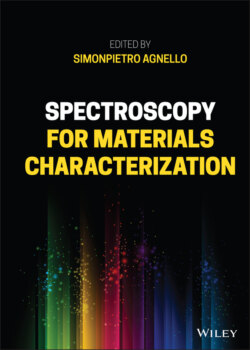Читать книгу Spectroscopy for Materials Characterization - Группа авторов - Страница 70
3.6 Case Studies 3.6.1 Ultrafast Relaxation Dynamics of Molecules in Solution Phase
ОглавлениеTransition metal complexes, such as metal–polypyridine complexes, are very interesting for several photochemical and solar energy harvesting applications, such as dye‐sensitized solar cells (DSSCs). The excited state dynamics of these molecules display several phenomena which make them a particularly interesting topic in the “ultrafast” community. One of the typical electronic absorption bands of many metal complexes, named metal‐to‐ligand charge transfer (MLCT), involves an optical charge transfer from the metal to the ligands around it. Excitation within MLCT electronic transitions is the first step toward electron injection in DSSCs, and gives rise to peculiar dynamical behavior which can only be addressed by ultrafast spectroscopic techniques.
It is known [68] that photoexcitation within the singlet 1MLCT state is typically followed by relaxation into a long‐lived triplet 3MLCT state, through an intersystem crossing (ISC) process, which can be surprisingly fast, well in the sub‐picosecond range. Because of such an extremely short 1MLCT fluorescence lifetime, its quantum yield is so small to make it practically invisible in steady state measurements. For the same reason, a direct observation of ISC in real time is very challenging, but can be achieved by FLUC, which allows to directly detect 1MLCT fluorescence and follow its dynamics as a function of time.
An example of this is reported by Cannizzo et al. [34]. The authors of this paper investigated the dynamics of an archetypal metal complex ([Ru(bpy)3]2+) by ultrafast fluorescence upconversion. In particular, they reported for the first time a FLUC experiment where the detection covered a broad wavelength range (440–690 nm) and, simultaneously, a time resolution of ≈110 fs. Photoexciting the metal complex with a very short excitation pulse at 400 nm allows them to follow the dynamics from the earliest stage, thus capturing the whole relaxation of the system.
The signal observed by FLUC [34] can be described as an emission band, peaking at 19 230 cm−1, which is attributed to 1MLCT emission and grows together with the excitation pulse. This band then decays within 200 fs while a weaker band appears at 16 500 cm−1. The latter corresponds to the steady state emission from the triplet state 3MLCT.
The detailed analysis of the temporal kinetics demonstrates that the bluest 1MLCT band rises and decays during the duration of the excitation pulse, and that also the rise of the redder band occurs during the pulse duration, suggesting that the population of the 3MLCT state is driven by an extremely fast ISC which lasts much less than the experimental time resolution. Deconvolution of the instrumental response function suggests an ISC timescale smaller than 30 fs, which implies in turn an extremely efficient spin–orbit coupling for this complex.
The shape of 1MLCT emission at zero time involves a large excitation–emission Stokes shift immediately after excitation. Analysis of the bandshape initially led to hypothesize that this transient 1MLCT emission is vibrationally “hot,” because 400 nm pump pulses selectively excite the v = 2 level of the Franck–Condon progression in absorption [34]. However, this issue was further addressed by later studies by the same group, which revealed instead that the transient 1MLCT fluorescence is vibrationally relaxed on ultrashort timescales [69], possibly even faster than the ISC process.
